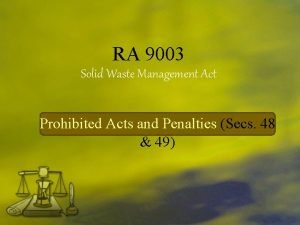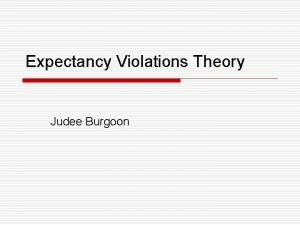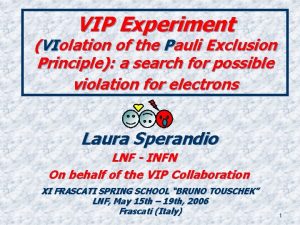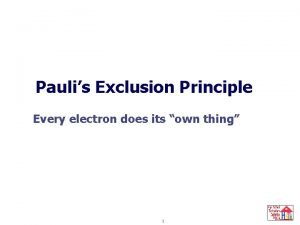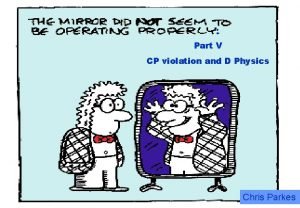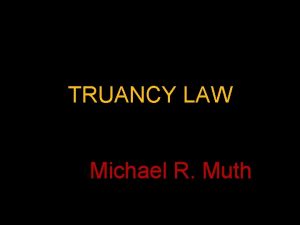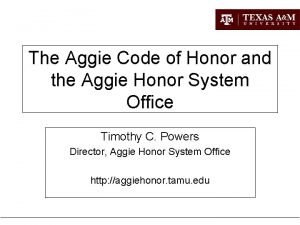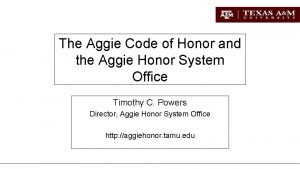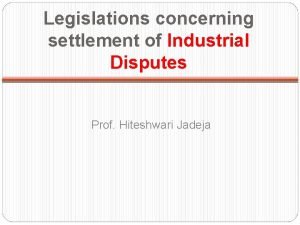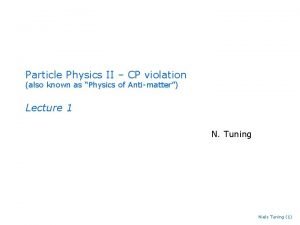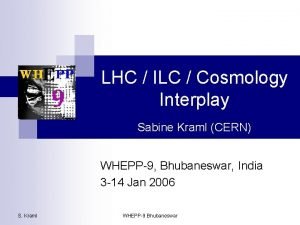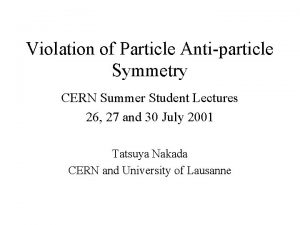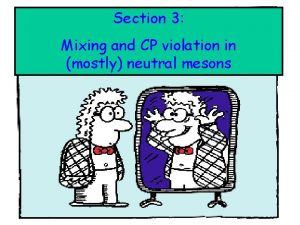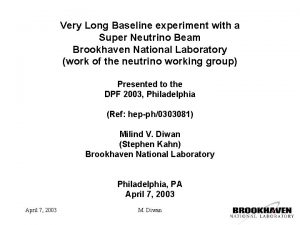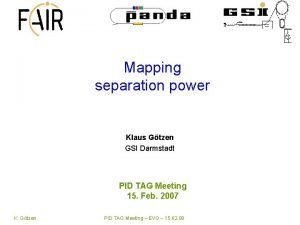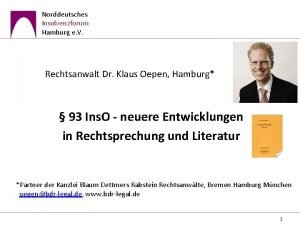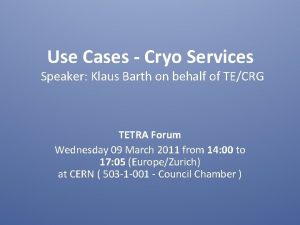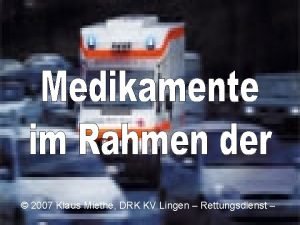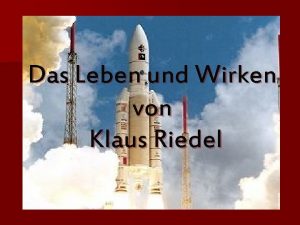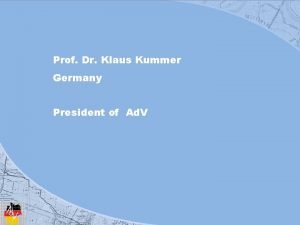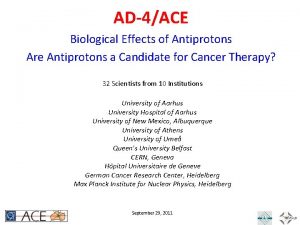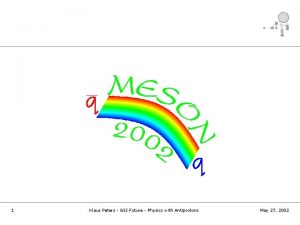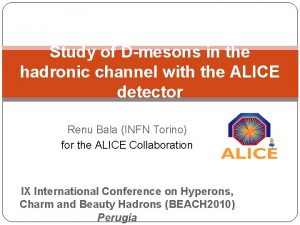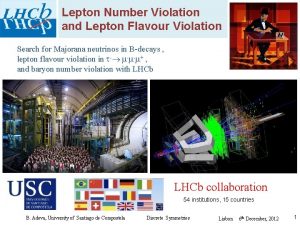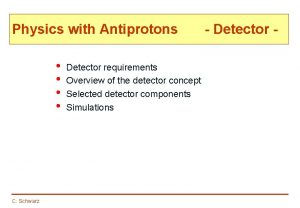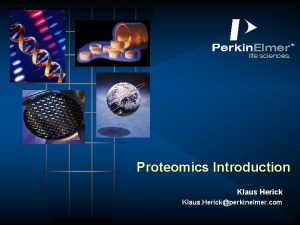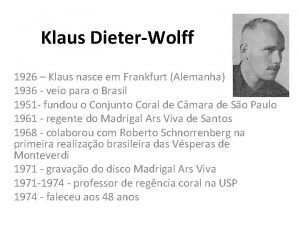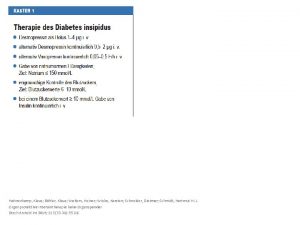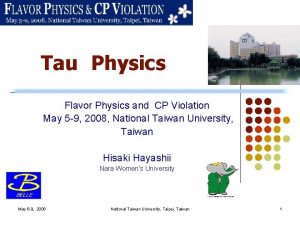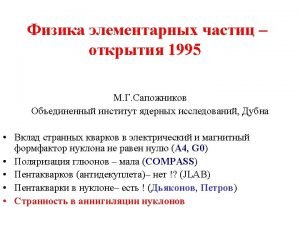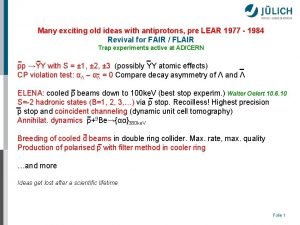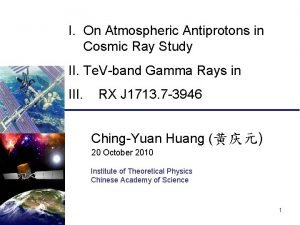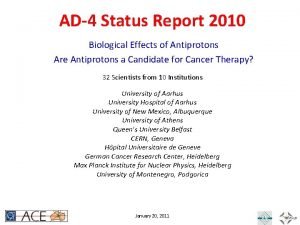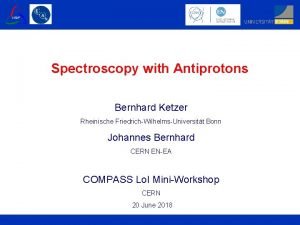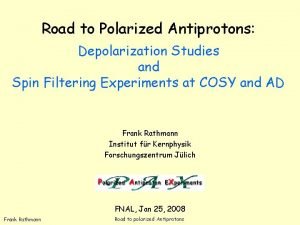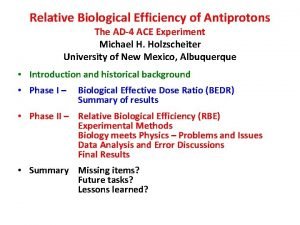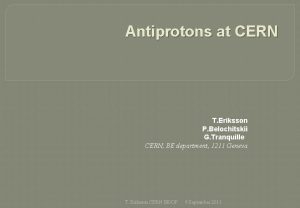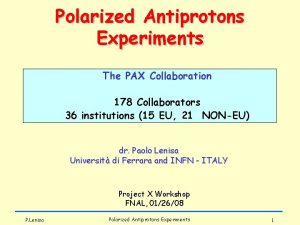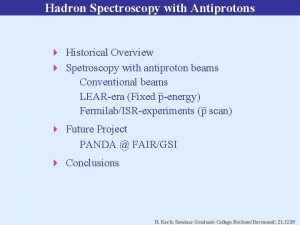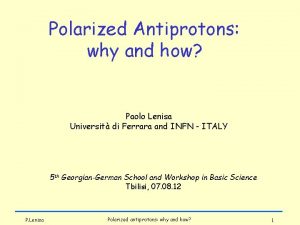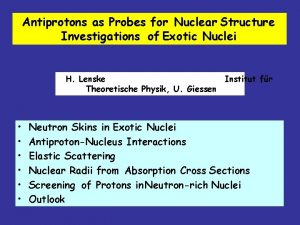Physics with antiprotons CP violation in Dmesons Klaus






































- Slides: 38

Physics with antiprotons: CP violation in D-mesons Klaus Peters Ruhr-Universität Bochum KVI Groningen Jan 7, 2003

Overview CP-Violation l Introduction l The K, B and D-case D-Mesons l Production l Decays Experimental Techniques Applications at PAn. Da l Experiments and Techniques l Requirements and Limitations 2 Klaus Peters, RUBochum, CP- Physics with D-Mesons at PAn. Da 7. 1. 2003

Motivation CP-Violation was first observed 1963 l Christenson, Cronin, Fitch & Turlay The origin is not well established yet l SM, QCD, non-SM, … CP-Violation – important for l Baryogenesis l Baryon asymmetry Is well measured in the K-System and observed in the B-System le’/e, sin 2 b, sin 2 a No evidence in D-Systems yet l SM prediction: small, discovery ® new physics 3 Klaus Peters, RUBochum, CP- Physics with D-Mesons at PAn. Da 7. 1. 2003

Quark-Mixing Not all neutral mesons are C-Eigenstates (like the p 0) but K 1 and K 2 are CP-Eigenstates 4 Klaus Peters, RUBochum, CP- Physics with D-Mesons at PAn. Da 7. 1. 2003

Types of CP Violation 2 I I 5 F + F I _ I =/ 2 _ F =/ 2 _ I _ F direct CP Violation 2 _ I I _ I Klaus Peters, RUBochum, CP- Physics with D-Mesons at PAn. Da F _ F + _ I 2 I F 7. 1. 2003

The Kaon Case Observation: l K 0 S ct=2. 68 cm decay dominant 2 p, CP=+1 l K 0 L ct=15. 51 m decay dominant 3 p, CP=-1 l Dm=(3. 49± 0. 04)x 10 -12 Me. V/c 2 but sometimes l |e|=(2. 282± 0. 017)x 10 -3 ~ G(KL® 2 p)/G(KS® 2 p) a K 0 L decays to 2 p dominated by mixing l in addition there is also direct CP violation without mixing l Re(e’/e)=(1. 8± 0. 4)x 10 -3 6 Klaus Peters, RUBochum, CP- Physics with D-Mesons at PAn. Da 7. 1. 2003

Analysis Overview f®KSKL Concept 1 –Tagged Mode l Identify KS • neither definite CP nor Flavor l Measure decay time differences l Tagging – Systematics! Concept 2 - Untagged Mode l Measure decay time difference untagged l No systematics due to tagging l smaller statistics since both final states must be similar (like f(®KSKL)®p+p-p 0 p 0) 7 Klaus Peters, RUBochum, CP- Physics with D-Mesons at PAn. Da 7. 1. 2003

The Dafne Detector e+e-®f(1020) l KS : Large decay volume: low density TPC l Main CP channel f®KSKL®p+p-p 0 p 0 l g–detection for neutral p 0 reconstruction 8 Klaus Peters, RUBochum, CP- Physics with D-Mesons at PAn. Da 7. 1. 2003

The CKM Matrix Wolfenstein Parameterization O(l 4) Unitarity relation e. g. A=(r, h) l Vub. Vud*+Vcb. Vcd*+Vtb. Vtd*=0 l can be expressed as a triangle in complex space CP-Violation parameters la, b and g, measured quantity sin 2 f 9 e’/e a g C=(0, 0) Klaus Peters, RUBochum, CP- Physics with D-Mesons at PAn. Da b B=(1, 0) 7. 1. 2003

The B-Meson Case: closing the triangle l The lifetime difference in the B-System is much smaller than in the K-System l instead of nearly perfect CP-Eigenstates KS/KL strong Eigenstates l CP violation appears in the time dependent decay rate 10 Klaus Peters, RUBochum, CP- Physics with D-Mesons at PAn. Da 7. 1. 2003

Analysis Overview Y(4 s)®BBbar Basic concept Measure the B 0 time dependent decay rate of channels with definite CP l Need to know the flavor of the B 0 – Flavor Tagging! l Although 2 B’s are present – only need to reconstruct B 0 CP fully if one can “measure” the flavor of the Btag. l Gauge the Flavor-Tagging with fully reconstructed events To be included l Dilution due to Miss-Tag l Resolution smearing 11 Klaus Peters, RUBochum, CP- Physics with D-Mesons at PAn. Da 7. 1. 2003

Analysis Overview Y(4 s)®BBbar reconstruct exclusive B decays to CP and flavour Eigenstates and tag the flavour of “the other B” select Btag events with leptons and kaons from hadronic B decays and determine B flavour select BCP candidate (like B 0®J/y. K 0 S, etc. ) and Bflavor candidates (like B 0®D*-p+) measure Miss-Tag wi and determine dilution Di=1 -2 wi effective Qi=(1 -2 wi)2 measure Dz between BCP and Btag and determine the signed time difference Dt between decays 12 Klaus Peters, RUBochum, CP- Physics with D-Mesons at PAn. Da 7. 1. 2003

The Ba. Bar Detector 1. 5 T solenoid Cs. I(Tl) EMC DIRC (PID) e+ (3. 1 Ge. V) Drift Chamber e- (9 Ge. V) Instrumented Flux Return Silicon Vertex Tracker Tracking : s(p. T)/p. T = 0. 13% PT + 0. 45% DIRC : K-p separation >3. 4 s for p<3. 5 Ge. V/c EMC: E/E = 2. 3% E-1/4 1. 9% 13 Klaus Peters, RUBochum, CP- Physics with D-Mesons at PAn. Da 7. 1. 2003

BABAR: Silicon Vertex Tracker 5 layers double sided 150. 000 channels surface ~1 m 2 point resolution s=15(40) mm for inner (outer) layers single vertex resolution s ~70 mm stand-alone tracking for low pt particles (<120 Me. V/c) 14 Klaus Peters, RUBochum, CP- Physics with D-Mesons at PAn. Da 7. 1. 2003

D-Mesons – Basic Properties Charm (c) + Light Quark (u, d, s) H-Atom of QCD decay: destroying charm quantum number l no strong decays l only weak (or non-SM) decays l long lifetimes ct ~ 100 -300 mm many channels into light mesons l individual channels are usually rare 15 Klaus Peters, RUBochum, CP- Physics with D-Mesons at PAn. Da 7. 1. 2003

D(S)-Decays W-emission (external) W-emission (internal) c c W W u, d, s W-annihilation W-exchange c c W W d, s u, d, s 16 Klaus Peters, RUBochum, CP- Physics with D-Mesons at PAn. Da 7. 1. 2003

D(S)-Decays Cabbibo-Suppression Colour-Suppression: l CKM-Matrix: l allowed transitions Vii~1 (cosqc) l suppressed transitions Vij<1 (sinqc) l W-Boson creates a Quark. Antiquark-Pair with matching colour-anticolour (~1/32=1/9) q u c = ~cosqc ~sinqc ~-sinqc~cosqc d W s _ q 17 Klaus Peters, RUBochum, CP- Physics with D-Mesons at PAn. Da 7. 1. 2003

D(S)-Decays D 0 c _ u c + D _ d DS 18 c +_ s W W W u _ d p+ s _ u K- u _ d s _ d u _ d s _ s c W D 0 _ K 0 c W D+ c DS W + _ s Klaus Peters, RUBochum, CP- Physics with D-Mesons at PAn. Da s _ d u _ d p+ f u _ u p+ s _ d u _ s _ K 0 p 0 _ K 0 p+ _ K 0 K+ 7. 1. 2003

The D-Meson Case: discovery opportunities for direct effects The DDbar mixing diagrams are suppressed l small mass of d-, s- and b-quarks ~f(ms)-f(md) BBbar and KKbar enhanced l due to t-quark mass ~mt 2 Using x. D=Dm/G and y. D=DG/2 G l Osc. parameter r. D=1/2 (x. D 2+y. D 2) l r. D=G(D 0®l-X)/G(D 0®l+X) ® only bounds l SM prediction r. D=10 -8 with possible strong phase d between RS and WS l x‘=x cosd+y sind l y‘=y cosd-x sind 19 Klaus Peters, RUBochum, CP- Physics with D-Mesons at PAn. Da 7. 1. 2003

D-Mesons: Mixing and Indirect CP Violation „Wrong sign“ (WS) D 0 decays l either produced via DCS or mixing and CFD l mixing parameter y can be extracted from lifetime ratio y=t. Kp/t. KK-1 l Kp has no certain CP parity l K+K- is a CP even mode Indirect CP violation occurs in the mixing l if l expected asymmetry is very small (~10 -5) l only new physics can lead to asymmetries as large as 1% 20 Klaus Peters, RUBochum, CP- Physics with D-Mesons at PAn. Da 7. 1. 2003

D-Mesons: Experimental results and predictions new physics y SM x SM 21 Klaus Peters, RUBochum, CP- Physics with D-Mesons at PAn. Da 7. 1. 2003

D-Mesons: Direct CP violation Recently observed in K meson decays (NA 48/k. Te. V) l requires two coherent amplitudes with l different weak phases and strong phases l only SCS decays can be used where tree and one-loop penguin interfere l expected asymmetry ACP ~ l-2 ~ 10 -3 l possible decay modes D 0®K+K-, p+p-, KSp 0, p 0 p 0, KSKS or D+®KSp+ 22 Klaus Peters, RUBochum, CP- Physics with D-Mesons at PAn. Da 7. 1. 2003

D(S)-Production Photo-Production D g Central Production h g g, P D D g g p D g g, P E 687, E 791, E 831 (Focus) 23 Klaus Peters, RUBochum, CP- Physics with D-Mesons at PAn. Da p E 769 7. 1. 2003

Photo-Production E 687 24 Klaus Peters, RUBochum, CP- Physics with D-Mesons at PAn. Da 7. 1. 2003

D(S)-Production Fragmentation@Y(4 s) e+ e- B-Decays D np/K W h D B l, nl D D B Babar, Belle, Cleo-C h W B 25 Klaus Peters, RUBochum, CP- Physics with D-Mesons at PAn. Da D 7. 1. 2003

D(S)-Production Threshold production e+ D e- D Mark-III, Cleo-C p _ p D D D Panda 26 Klaus Peters, RUBochum, CP- Physics with D-Mesons at PAn. Da 7. 1. 2003

D-Physik @ CLEO-C (CESR-C) in 2003 CESR-c and CLEO-c become operational l sqrt(s)=3 -5 Ge. V/c 2 l L=(1. 5 -4. 4) x 1032 cm-2 s-1 l 3 yr. running envisaged Ecm L Int L Ge. V 1032 cm-2 s-1 fb-1 3. 1 1. 46 0. 5 (4 m) 1. 3 x 109 J/y 3. 69 ~4. 1 1. 5 (4 m) 109 y‘ 3. 77 ~4. 13 3 (9 m) 3 x 107 DD 4. 14 ~4. 4 3 (9 m) 1. 5 x 105 Ds. Ds 4. 6 ~4. 4 1 (3 m) 4 x 105 LCLC 27 Events Klaus Peters, RUBochum, CP- Physics with D-Mesons at PAn. Da 7. 1. 2003

Proposed Panda Detector (Overview) High Rates l Total s ~ 55 mb Vertexing l (sp, KS, L, …) Charged particle ID l (e±, m±, p, …) Magnetic tracking Elm. Calorimetry l (g, p 0, h) Forward capabilities l (leading particles) Sophisticated Trigger(s) 28 Klaus Peters, RUBochum, CP- Physics with D-Mesons at PAn. Da 7. 1. 2003

Panda-Vertexing: Micro Vertex Detector 7. 2 mio. barrel pixels 50 x 300 μm pellet/cluster pipe beam pipe 2 mio. forward pixels 100 x 150 μm Readout: ASICs (ATLAS/CMS) 0. 37% X 0 or pixel one side – readout other side (TESLA) 29 Klaus Peters, RUBochum, CP- Physics with D-Mesons at PAn. Da 7. 1. 2003

Panda-PID: DIRC (Cherenkov) Ba. Bar@SLAC less space than aero gel costs of calorimeter no problems with field 30 Klaus Peters, RUBochum, CP- Physics with D-Mesons at PAn. Da 7. 1. 2003

Charm and Double-Charm Production Charm production is not investigated in low energy ppbar reactions so far l First goal: measure charm (D-meson, C-Hyperon) production • reconstruct exclusive channels • measure inclusive cross sections • measure decay topologies l be prepared for surprises! • like double ccbar production in e+el in e+e-®J/y. X at Y(4 s), 60% of X contains ccbar! Use this input for the design of a CP-violation experiment at PAn. Da in a later stage 31 Klaus Peters, RUBochum, CP- Physics with D-Mesons at PAn. Da 7. 1. 2003

D-Pair Production and D*-Tagging D-mesons can be produced directly in ppbar reactions l Use D* mesons as a source for D 0 l B(D*+®D 0 p+)=68% l D*+®D 0 p+ is a CP-conserving strong decay l the charge of the slow! pion is an unbiased flavor tag for the D 0 l s(DDbar) ~ 100 -200 nb l rec. events ~106/year _ Alternative technique pp®p. LC+D 0 l with perfect flavor tag l but yield unknown and no dominant LC decay channel 32 Klaus Peters, RUBochum, CP- Physics with D-Mesons at PAn. Da 7. 1. 2003

D-Trigger Properties for a possible trigger l lifetimes 100 -300 mm l slow (recoil) pions from D* l moderate multiplicities l associated production l Lifetimes and momenta require a high trigger level (reco!) l multiplicities and KS multiplicity jumps are available “in hardware” Associated production l Need to trigger on one D • D+®KSX = (30± 4)% • D+®K±X = (30± 3)% • D 0®KSX = (21± 3)% • D 0®K±X = (56± 4)% l An efficient trigger on charged K’s and K 0 S will maintain more than 50% of the DDbar events Hadronic background: l reduced by f~10 -2 • ppbar®KSX • ppbar®K±X 33 Klaus Peters, RUBochum, CP- Physics with D-Mesons at PAn. Da ~<10 -2 stot 7. 1. 2003

Other CP-Measurements in ppbar Non-leptonic decays (|DS|=1) proceed by parity-violating weak interaction angular momentum L=0, 1 ® P=(-1)L ® interference l between S- and P-wave or |DI|=1/2 and 3/2 l observed quantities are angular distribution asymmetry a l and baryon decay polarization b (from X decays) 34 Klaus Peters, RUBochum, CP- Physics with D-Mesons at PAn. Da 7. 1. 2003

The Hyperon Case: CP conservation implies measure SM prediction A~10 -4 -10 -5 s~ 65 mb (LL), 2 mb (X+X-) NL ~ 109/month NX~ 3 x 107/month 35 Klaus Peters, RUBochum, CP- Physics with D-Mesons at PAn. Da 7. 1. 2003

The GSI Future Project Panda Existing GSI Facilities 36 Klaus Peters, RUBochum, CP- Physics with D-Mesons at PAn. Da 7. 1. 2003

Summary and Outlook The origin of CP violation is still unclear Using any available tool is mandatory to understand a basic feature of our subnuclear structure The D-system is a great opportunity to study direct CP-violation The new facility at GSI provides a possibility to test CP violation in l D-mesons and l Hyperon decays 37 Klaus Peters, RUBochum, CP- Physics with D-Mesons at PAn. Da 7. 1. 2003

GSI & PAn. Da: More Information http: //www. gsi. de/GSI-Future/project/eng/i/pdf_e. gif http: //www. gsi. de/GSI-Future/cdr/ http: //www. gsi. de/GSI-Future/project/eng/index. php 38 Klaus Peters, RUBochum, CP- Physics with D-Mesons at PAn. Da 7. 1. 2003
 I'm going to law
I'm going to law Port security violation
Port security violation Mosaic plagiarism definition
Mosaic plagiarism definition Prohibited acts of ra 9003
Prohibited acts of ra 9003 Connecticut judicial branch
Connecticut judicial branch Expectancy violation theory definition
Expectancy violation theory definition Pauli exclusion principle violation
Pauli exclusion principle violation Family code of ethics
Family code of ethics Altering a license may result in
Altering a license may result in Virginia probation violation sentencing guidelines
Virginia probation violation sentencing guidelines Pauli exclusion principal
Pauli exclusion principal Ferpa violation
Ferpa violation Type of violation
Type of violation Violation of compulsory attendance req parent, etc
Violation of compulsory attendance req parent, etc The recognized violation of cultural norms
The recognized violation of cultural norms Aggie code of honor
Aggie code of honor Aggie code of honor
Aggie code of honor When employees resort to unauthorized strike in violation
When employees resort to unauthorized strike in violation Charge parity violation
Charge parity violation Family educational rights and privacy act
Family educational rights and privacy act Spectrum ilc 1002
Spectrum ilc 1002 Lsr violation
Lsr violation Type of violation
Type of violation Communicator reward valence
Communicator reward valence Traffic control violation sap
Traffic control violation sap Cp-violation
Cp-violation It is defined as the recognized violation of cultural norms
It is defined as the recognized violation of cultural norms Ferpa violations
Ferpa violations Code cave utilization
Code cave utilization Cp-violation
Cp-violation What is the sussex pledge
What is the sussex pledge Klaus gotzen
Klaus gotzen Klaus oepen
Klaus oepen Klaus barth
Klaus barth Glucose 40 rettungsdienst
Glucose 40 rettungsdienst Dymphna van den boom
Dymphna van den boom Klaus peter schipper
Klaus peter schipper Klaus riedel
Klaus riedel Klaus kummer
Klaus kummer



